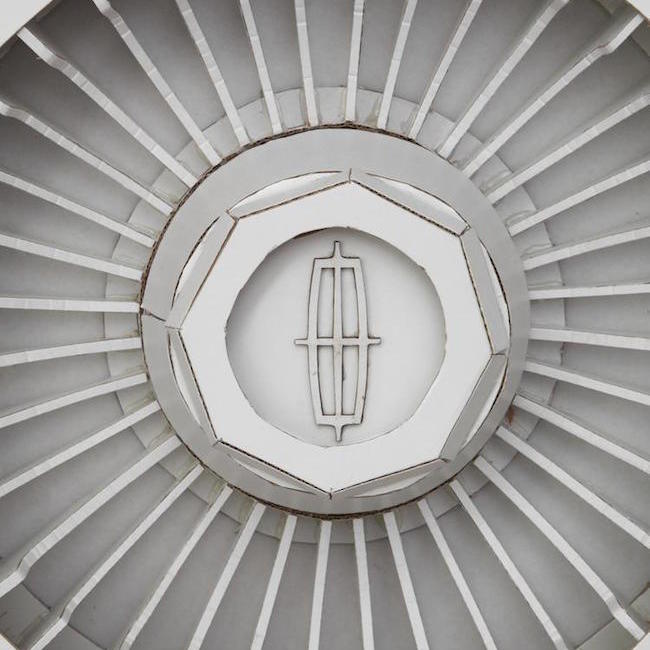A ghostly Lincoln Continental, detailed in cardboard down to the speedometer, is parked in the middle of the Susanne Hilberry Gallery in Michigan. Built by artist Shannon Goff for her cardboard and clay exhibition (Ferndale, September 19 — November 14, 2015), the car, titled Miles to Empty, is like a tease to Detroit’s industrial roots. You can read about the clay portion of the exhibition here.
Goff’s work begins in a personal space. Calling it her “most ambitious work to date,” she says the Continental is an homage to her grandfather and a memorial to the city of Detroit. She states:
“It’s about memory and loss. One of the main goals of Miles to Empty is to steer viewers to re-examine American society’s fixations on power, luxury, and autonomy. It’s a reliquary for the American dream and the fantasy of the Open Road.”
The artist begins with a personal story, but the narrative, framed like a car commercial (note the words “power” and “luxury”), has vitality beyond Goff’s own experience. Through this inverted car commercial there are tools one can use to understand the complicated relationship people from de-industrialized cities have with their hometowns. There’s nuance stashed in the Continental’s glovebox.
This is just one reading of Miles to Empty. There are more to be found, testaments to the potency of Goff’s cardboard sculpture.
To those from the Rust Belt it’ll feel like familiar territory. We’re used to reflecting on our region’s economic past; it’s a way to pass the time while we watch the factories fall apart around us. Typically this reflection takes the form of overwrought, over-emotional lamentations about lost greatness, the kind of caterwauling pap that Bruce Springsteen churns out by the barrel. Goff respects your intelligence, though, so she’s not going to club you about the face and neck with a narrative you can recite in your sleep by now.
For a hot minute, the steel industry in my old town brought prosperity, a booming population, art, culture, and beautiful architecture that can stand against most other buildings in the country. It also piled soot on the doorsteps of every person who lived there, polluted the river, maimed generations of laborers, and at times hired thugs to shoot union members in the street. Factory owners exploited racial differences, preferring for obvious reasons a divided, segregated work force. The factories picked up and left decades ago, but that racial tension is branded on the consciousness of everyone who lives there today. The land where the steel mills used to be resembles nothing else as much as dark, ragged scars.


Still, the woe-is-me mentality is the dominant mode in my old home. People mourn a system that —at best— was callously indifferent to their wellbeing. I imagine it’s the same in most U.S. cities with similar stories. A sense of nuance is desperately, sorely needed in our conversations about the past.
Goff’s Continental is lovingly-detailed. Everything you’d want in the classic automobile is there; it has all the bells-and-whistles, all the features. More than that, the contours are perfect, the grill, the housing for the tail lights. Absolutely nothing was forgotten; Goff even took care to replicate the dashboard vents.
For all of that the sculpture might as well be made of smoke. It seems to exist in limbo and I wouldn’t be surprised to find that my hand passes through if I attempt to touch it. It makes me wonder whether Goff’s excellent reproduction is also an illusion. And, since she was so faithful in her reproduction, what about a real Lincoln Continental? I’m not reaching any definite conclusions, but what Goff has given me are more options for how I think about the past. She skews the familiar, so slightly, just enough to set you loose in a space with more mental breathing room.
Goff’s show includes many ceramic sculptures, which we show in the companion piece to this post.
Bill Rodgers is the General Editor of cfile.
Love contemporary ceramic art + design? Let us know in the comments.

Artist photograph by Naoko Komori.



Add your valued opinion to this post.